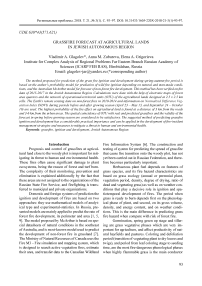Grassfire forecast at agricultural lands of the Jewish autonomous region
Автор: Glagolev Vladimir A., Zubareva Anna M., Grigorieva Elena A.
Журнал: Региональные проблемы @regionalnye-problemy
Рубрика: Climate change: challenges for agricultural environment
Статья в выпуске: 3-1 т.21, 2018 года.
Бесплатный доступ
The method proposed for prediction of the grass fire ignition and development during spring-autumn fire period is based on the author’s probability model for prediction of wild fire ignition depending on natural and man-made conditions, and the Australian McArthur model for forecast of non-forest fire development. This method has been verified on fire data of 2015-2017 in the Jewish Autonomous Region. Calculations were done with the help of electronic maps of forest area quarters and the network of operational-territorial units (OTU) of the agricultural lands designed at 2.5 x 2.5 km cells. The Earth’s remote sensing data on non-forest fires in 2010-2014 and information on Normalized Difference Vegetation Index (NDVI) during periods before and after growing season (April 23 - May 13, and September 24 - October 10) are used. The highest probability of the fire effect on agricultural land is found at a distance of 3 km from the roads and 3-6 km from the urban areas. The spatial coincidence of OTU with real and predicted grassfires and the validity of the forecast in spring before growing season are considered to be satisfactory. The suggested method of predicting grassfire ignition and development has a considerable practical importance and can be applied in the development of fire-incident management strategies and measures to mitigate a threat to human and environmental health.
Grassfire, ignition and development, jewish autonomous region
Короткий адрес: https://sciup.org/143165327
IDR: 143165327 | УДК: 630*43(571.621) | DOI: 10.31433/1605-220X-2018-21-3(1)-93-97
Список литературы Grassfire forecast at agricultural lands of the Jewish autonomous region
- Baranovskiy NV, Kogan RM, Glagolev VA, Zubareva AM (2017) Grassland fire spread simulation using NDVI data. In Proc. SPIE 10466, 23rd International Symposium on Atmospheric and Ocean Optics: Atmospheric Physics, 104663B (30 November 2017); SPIE, p. 104663В DOI: 10.1117/12.2286782
- Dorrer GA (2008) Dynamics of forest fires . Novosibirsk: Izd-vo SO RAN, 404
- Glagolev VA, Zubareva AM (2017) Information system for estimation of complex pirological index in Khabarovsky Krai and Jewish Autonomous Region. Regional Problems 20(2): 50-56
- Grigorieva EA, Kogan RM (2010) Fire risk characteristic of climate at the Russian Far East. Regional Problems 13(2): 78-81
- Grishin AM (1994) Physics of forest fires . Tomsk: Tomskiy University, 218
- Khodakov VE, Zharikova MV (2011) Firest fires: methods of assessment . Kherson: Grin D.S., 410
- Kuznetsov GV, Baranovskiy NV (2009) Forecast of forest fires ignition and their effect on environment . Novosibirsk: SO RAN, 301
- McArthur AG (1966) Weather and grassland fire behavior. Leaflet 100. Forestry and Timber Bureau. Common-welth of Australia
- Sofronov MA, Volokitina AV, Sofronova TM (2005) Forest fire management: textbook for students . Krasnoyarsk: SibGTU. 144
- Verhulst N, Govaerts B (2010) The normalized difference vegetation index (NDVI) GreenSeekerTM handheld sensor: Toward the integrated evaluation of crop management. Part A: Concepts and case studies. Mexico, D.F.; CIMMYT. 14 p


